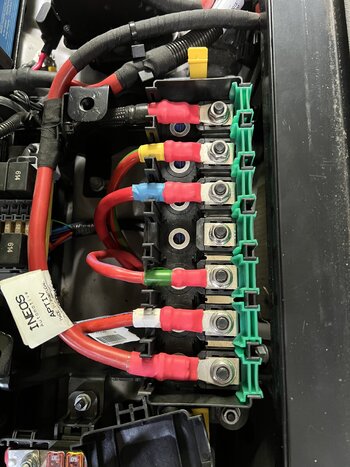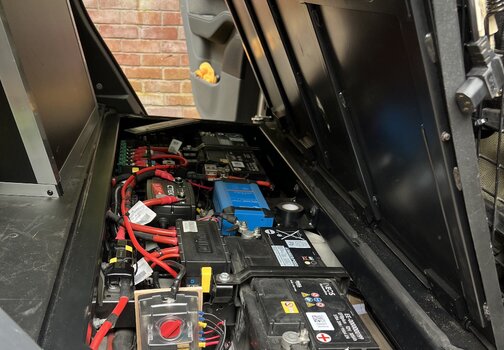Why does the "Consumers" lug on the Smartpass 120 come with a warning label not to use it. The consumers lug on the CTEK Smartpass dual battery system is there to be used for accessories, such as refrigerators, camp lighting, radios or other electrical equipment you do not want to connect to the starting battery. Why did Ineos engineers chose to delete this function? The reason I opted for a dual battery system is because of this feature. Can we use it anyway without issues?
The Grenadier Forum
Register a free account today to become a member! Once signed in, you'll be able to contribute to the community by adding your own topics, posts, and connect with other members through your own private inbox! INEOS Agents, Dealers or Commercial vendors please use the contact us link at the bottom of the page.
-
Guest submit your best shot for a chance to win the December Photo Contest. Photo Contest Click Here
You are using an out of date browser. It may not display this or other websites correctly.
You should upgrade or use an alternative browser.
You should upgrade or use an alternative browser.
Americas Dual battery option using the CTEK Smartpass 120
- Thread starter Lars
- Start date
- Featured
-
- Tags
- battery ctek dual dual battery
Philosophical system design choice. Run everything off starter batt. If it gets depleted then you have a backup to start the car and get it recharged again via the alternator.
Last edited:
There was also some talk about owners overloading the circuit.Why does the "Consumers" lug on the Smartpass 120 come with a warning label not to use it. The consumers lug on the CTEK Smartpass dual battery system is there to be used for accessories, such as refrigerators, camp lighting, radios or other electrical equipment you do not want to connect to the starting battery. Why did Ineos engineers chose to delete this function? The reason I opted for a dual battery system is because of this feature. Can we use it anyway without issues?
I just run my accessories circuit from my aux battery terminals - wire gauge for 50 amp circuit, with 40 amp inline midi fuse.
Last edited:
Yes, it was a engineering design choice and there are work-arounds, but that doesn't answer the question...Why did they choose to delete the feature that allows accessories to be powered off the main/aux battery with built-in low battery cut-off and a continuous rating of 80A. It's a feature that was built into CTEC system they chose. Why not use it? Can we use it anyway? I guess the easy answer is that, once again, they thought we needed a parent in room to tell us no or we would use it improperly.
If you can remove the plug you can use the Ctek as designed and run house loads off the second battery.Yes, it was a engineering design choice and there are work-arounds, but that doesn't answer the question...Why did they choose to delete the feature that allows accessories to be powered off the main/aux battery with built-in low battery cut-off and a continuous rating of 80A. It's a feature that was built into CTEC system they chose. Why not use it? Can we use it anyway? I guess the easy answer is that, once again, they thought we needed a parent in room to tell us no or we would use it improperly.
I 1/2 way finished digging the plug out to do so. It’s really stuck in there = 1-way application!!!
The early owners like me, had the original CTEK screw, and no warning that we were not allowed to use it. Once I heard that Ineos would replace this with a glued plug, I removed the screw and I told my dealer NOT to glue the Ineos plugIf you can remove the plug you can use the Ctek as designed and run house loads off the second battery.
I 1/2 way finished digging the plug out to do so. It’s really stuck in there = 1-way application!!!
But, as a (former) electronic engineer, I would like to get an explanation from Ineos why we shouldn't use it, because I don't see any reason why not. And we asked it, but never got an answer.
In Nov 2023 Ctek issued a safety notice for the smartpass 120S stating the smartpass is not reverse polarity protected and increased it's safety installation requirements. The safety notice, original and replaced manuals can be found on the Ctek website. At the same time Ctek reduced the consumer output of the Smartpass from 80amps to 50 and also provided free of charge a metal standoff if used on a non metallic surface. IMHO I do not think it was a coincidence that Ineos decided to remove the function of the consumer out. Whilst Ctek has REDUCED the risk associated with using the consumer out by dropping output from 80amps to 50 (one can take a guess what this risk was) Ineos on the other hand REMOVED the risk entirely.
Thanks added to the links.In Nov 2023 Ctek issued a safety notice for the smartpass 120S stating the smartpass is not reverse polarity protected and increased it's safety installation requirements. The safety notice, original and replaced manuals can be found on the Ctek website. At the same time Ctek reduced the consumer output of the Smartpass from 80amps to 50 and also provided free of charge a metal standoff if used on a non metallic surface. IMHO I do not think it was a coincidence that Ineos decided to remove the function of the consumer out. Whilst Ctek has REDUCED the risk associated with using the consumer out by dropping output from 80amps to 50 (one can take a guess what this risk was) Ineos on the other hand REMOVED the risk entirely.
ELECTRICS/CTEK120S CONSUMER OUTPUT: The likely reason why INEOS stopped access to the consumer output on the 120S here;
I'll add my own view to this. This is based on wider reading and deduction with some assumptions, which could be wrong. I've said most of this before but we don't have forum wiki's so there's no single repository to develop subject-based technical knowledge within the forum.In Nov 2023 Ctek issued a safety notice for the smartpass 120S stating the smartpass is not reverse polarity protected and increased it's safety installation requirements. The safety notice, original and replaced manuals can be found on the Ctek website. At the same time Ctek reduced the consumer output of the Smartpass from 80amps to 50 and also provided free of charge a metal standoff if used on a non metallic surface. IMHO I do not think it was a coincidence that Ineos decided to remove the function of the consumer out. Whilst Ctek has REDUCED the risk associated with using the consumer out by dropping output from 80amps to 50 (one can take a guess what this risk was) Ineos on the other hand REMOVED the risk entirely.
The raison d'être* of the auxiliary battery is to act as a safety device to protect the starter battery. If your beer fridge pulls the main battery down the auxiliary battery will pulse charge it so you should always be able to start the vehicle.
This is evident in the IA (Magna) decision to use a Smartpass 120S instead of a D250SE; because the D250SE is principally a one-way device to charge a second battery. It doesn't have the same two-way capabilities or current handling capacity of the Smartpass.
As Jean notes, early MY23 builds got a Ctek branded Smartpass 120S with a 80A consumer terminal. This was derated from 80A to 50A from November 2023 as Paul Baker has noted.
Subsequent vehicle builds got a debranded unit without a consumer terminal based on the Smartpass 120S product but called a Battery Combiner because that's all IA need it to do: combine the batteries so the auxiliary battery can monitor and protect the main battery by sending power to it when required. I think IA always wanted just a combiner but Ctek weren't ready so the early builds got a fully featured Smartpass 120S which was castrated when the plastic plug got fitted.
Allowing a power drain of up to 50A via the consumer terminal is contrary to IA's application. The auxiliary battery cannot do its job if the owner has discharged it while the vehicle is switched off. It's why consumer loads should be applied to the main battery. IA want a no-go zone around the connection with the auxiliary battery and the battery hence the removal of the ability to draw power from the consumer terminal.
The IA system differs from a conventional direct-connected parallel battery 'bank'. The IA system can be described as an electronically-coupled, bidirectional, two-battery system. Same 12V architecture as single battery vehicles but gives managed access to an auxiliary 'reserve power' battery for use when needed by the main battery (not your beer fridge).
A conventional parallel battery bank offers twice the Ah and twice the cranking amps (CCA) for powering consumers and starting the engine, but when the bank runs down there's nothing in reserve. This is the key point of difference with the IA system. The auxiliary battery is preserved to top up a depleted main battery.
Of course the auxiliary battery option is no longer offered in new orders so those wanting equivalent functionality could just carry a lithium jump starter and put their savings towards a dual-battery system they actually want.
But, my ramblings aside, it would be good to hear from IA on this subject.
*Some cultural flex there. Don't worry, I'm still beaten by yoghurt.
Last edited:
I'll add my own view to this. This is based on wider reading and deduction with some assumptions, which could be wrong. I've said most of this before but we don't have forum wiki's so there's no single repository to develop subject-based technical knowledge within the forum.
The raison d'être* of the auxiliary battery is to act as a safety device to protect the starter battery. If your beer fridge pulls the main battery down the auxiliary battery will pulse charge it so you should always be able to start the vehicle.
This is evident in the IA (Magna) decision to use a Smartpass 120S instead of a D250SE; because the D250SE is principally a one-way device to charge a second battery. It doesn't have the same two-way capabilities or current handling capacity of the Smartpass.
As Jean notes, early MY23 builds got a Ctek branded Smartpass 120S with a 80A consumer terminal. This was derated from 80A to 50A from November 2023 as Paul Baker has noted.
Subsequent vehicle builds got a debranded unit without a consumer terminal based on the Smartpass 120S product but called a Battery Combiner because that's all IA need it to do: combine the batteries so the auxiliary battery can monitor and protect the main battery by sending power to it when required. I think IA always wanted just a combiner but Ctek weren't ready so the early builds got a fully featured Smartpass 120S which was castrated when the plastic plug got fitted.
Allowing a power drain of up to 50A via the consumer terminal is contrary to IA's application. The auxiliary battery cannot do its job if the owner has discharged it while the vehicle is switched off. It's why consumer loads should be applied to the main battery. IA want a no-go zone around the connection with the auxiliary battery and the battery hence the removal of the ability to draw power from the consumer terminal.
The IA system differs from a conventional direct-connected parallel battery 'bank'. The IA system can be described as an electronically-coupled, bidirectional, two-battery system. Same 12V architecture as single battery vehicles but gives managed access to an auxiliary 'reserve power' battery for use when needed by the main battery (not your beer fridge).
A conventional parallel battery bank offers twice the Ah and twice the cranking amps (CCA) for powering consumers and starting the engine, but when the bank runs down there's nothing in reserve. This is the key point of difference with the IA system. The auxiliary battery is preserved to top up a depleted main battery.
Of course the auxiliary battery option is no longer offered in new orders so those wanting equivalent functionality could just carry a lithium jump starter and put their savings towards a dual-battery system they actually want.
But, my ramblings aside, it would be good to hear from IA on this subject.
*Some cultural flex there. Don't worry, I'm still beaten by yoghurt.
So summing up the IA system it's just a single battery with doubled AH. It only looks like there's a second. That's how I think about it.
Not bad but not quite there.So summing up the IA system it's just a single battery with doubled AH. It only looks like there's a second. That's how I think about it.
If it acted as a single battery in two parts it would all be charged or all be flat because there is no isolation between the parts. That's how a parallel battery bank acts.
Look at this example (borrowed from here). If the circuit power demand exceeds the combined Ah capacity of A and B then both will be flat. That's not how the IA system works (although both batteries will still go flat if you wait long enough).
You could say it has a single (main) battery that supports the vehicle and a 2nd (auxiliary) battery that supports the main battery.
@Rok_Dr has an excellent write-up on the Smartpass operation in his Owner's Manual Supplement. Available from here.
Last edited:
Interesting and informative discussion. We may never know Ineos' side, but I guess it makes sense if you assume Ineos designed it as simply a back-up to the starter battery, and not how I, and probably many more people, intended to use it as a way to power accessories. My solution will be replace the CTEC with a different DC-DC controller that will support solar charging, lithium batteries and probably a lot more.
Ineos‘ focus is on new sales and ignoring customers that already have spent money or providing information to owners - best way to generate one-time buyers and not returning customersThe early owners like me, had the original CTEK screw, and no warning that we were not allowed to use it. Once I heard that Ineos would replace this with a glued plug, I removed the screw and I told my dealer NOT to glue the Ineos plug
But, as a (former) electronic engineer, I would like to get an explanation from Ineos why we shouldn't use it, because I don't see any reason why not. And we asked it, but never got an answer.
Agree.Why does the "Consumers" lug on the Smartpass 120 come with a warning label not to use it. The consumers lug on the CTEK Smartpass dual battery system is there to be used for accessories, such as refrigerators, camp lighting, radios or other electrical equipment you do not want to connect to the starting battery. Why did Ineos engineers chose to delete this function? The reason I opted for a dual battery system is because of this feature. Can we use it anyway without issues?
I thought I was buying a truck with a DC/DC charger, which completely isolates the house battery from the starter battery. That way, the house battery can be lithium. This obviously allows for far greater power density. Also, the starter battery would never be touched for utility use. This is the philosophy that all overland vehicles follow (at least in Australia and South Africa)
I do not regard the Ineos DC design choice as acceptable.
I do believe Ineos can and should provide a tech procedure to safely make this change. This would include the overhead switches and their power points to the isolated lithium house battery.
One can hope.
Similar threads
- Replies
- 0
- Views
- 323
- Replies
- 3
- Views
- 396
- Replies
- 11
- Views
- 2K
- Replies
- 19
- Views
- 2K
- Question
- Replies
- 17
- Views
- 2K





